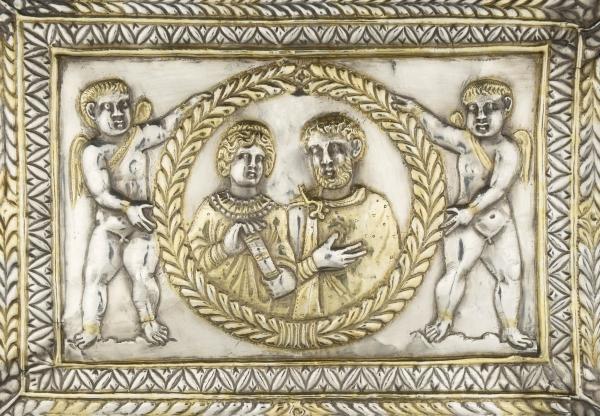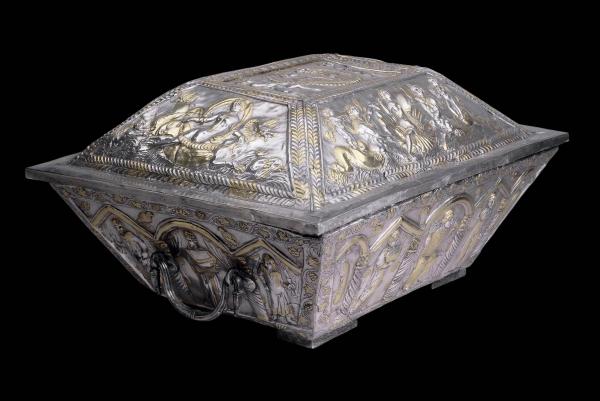The Esquiline treasure
A silver treasure comprising several pieces was discovered in a house at the foot of Esquiline Hill in Rome in 1793. A full inventory was not made after the discovery, thus it is not known exactly how many items the treasure had: researchers were able to verify altogether 27 silver objects making up the find. These pieces were acquired by three museums (in London, Naples and Paris) and of them the most (25 pieces) are held in the British Museum.
The Esquiline treasure comprises vessels used at banquets, items of toiletry sets, as well as fittings for furniture and for horses. Of these the most famous is a large ( 56 x 43 cm in size, 8.2 kg in weight) gilded silver toiletry casket decorated with reliefs probably made around 380. It was a wedding present: the casket lid is decorated with images of the young couple. Their names (Proiecta and Secundus) are mentioned in a Latin inscription on the rim of the casket lid – SECVNDE ET PROIECTA VIVATIS IN CHRISTO – which urges the owners to live in Christ. On the long side of the lid above the Christian inscription the scene of Aphrodite’s birth, while on the short sides the figures of Nereids accompanying her can be seen. On the back a young man is leading the bride accompanied by servants with gifts. On the side panels of the bottom part of the casket the bride is sitting on a chair with a toiletry casket in her hand, while servants are bringing her various objects for her beautification, such as a mirror, toiletry casket, a water jug, a situla (bucket) and wash bowl. Similar scenes decorate the cylindrical toilet casket of the Seuso treasure.
Another significant piece of the treasure is comparable to the toiletry casket that can be seen in a scene of the Proiecta. This is the circular, so-called Muse casket with a domed cover (approximately 33 cm in diameter and 27 cm in height). The treasure also includes a fluted hand or wash bowl (56 cm in diameter, 2.7 kg in weight) whose ornamentation shows parallel features with the geometric ewers of the Seuso treasure and the Kőszárhegy stand, a dish used for drink, eight gilded monogrammed silver plates with niello inlay, a flask decorated with animals and geometrical motifs, two ewers as well as six gilded fittings for horses. The four gilded silver statues presumably decorated a chair. They depict Tyche, the goddess of fortune and each represent a different city: Rome, Constantinople, Alexandria and Antioch.
The treasure belonged to a patrician family in Rome. On the basis of the inscription on the Proiecta casket, it can perhaps be connected to the Turcii, a family whose members had leading posts in the 4th century. The treasure consists of objects belonging to several members of the family. Twenty-two of the 27 items were presumably made in the same workshop within a short period of time. Its dating is disputed; it must have been hidden most probably around 380. Its total weight is approximately 28 kilograms and its value in gold amounts to some 1.823 kilograms.
Read more about the objects of the treasure:
The Esquiline Treasure, the British Museum
Bibliography:
Shelton, K. J.: The Esquiline treasure, London 1981


